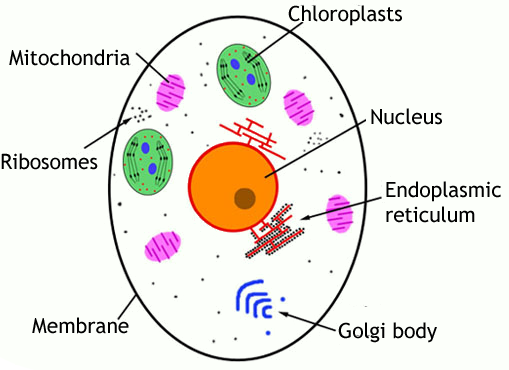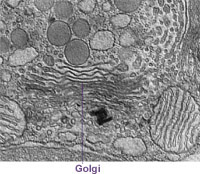Cell Structure
There are two major types of cell. eukaryotic cells, which have membrane-bound organelles, like a nucleus and mitochondrion; and prokaryotic which do not have these organelles.
Eukaryotic Cells
Below is a diagram of a typical eukaryotic cell. As you can see, it is much more complicated than the models you are presented with at lower levels of study.

Now that we have had a look at the different organelles that are found in animal and plant cells, we will go on to look at these organelles in more detail. An organelle is a body within a cell that has a partiular function. It is to the cell, what an organ is to your body.
| Name | Diagram | Description |
|---|---|---|
| Nucleus |  |
|
| Mitochndrion | ||
| Endoplasmic reticulum |  |
|
| Golgi Body |  |
|
| Chloroplasts | ||
Prokaryotic Cells
For more information about the structure of bacteria see bacteria.
This is a cell with no membrane-bound organelles. The best example of such a cell is a bacterium, the specific functions carried out by organelles are performed by other parts of a prokaryotic cell. Below is a theory which explains why bacteria do not have membrane-bound organelles.
Endosymbiosis
Pronounced [en - do - sim - by - oh - sis], and literally meaning living together inside, in Ancient Greek; this is a theory which explains the origins of some organelles in eukaryotic cells.
Organelles like chloroplasts and mitochondria both have a membrane, contain their own genetic material, and can produce food. And this theory (now generally accepted by biologists) says that these were once bacteria that lived independently.
However, many millions of years ago, in the early stages of life on earth; the mitochondria (as bacteria) developed a symbiotic relationship with other cells. A symbiotic relationship is where two organisms live in close proximity to each other, or maybe one inside the other. Such a relationship exists in your digestive system where bifidobacterium baceria live and help with digestion.
Over millions of years of this relationship, the two cells are so dependent on each other that they can't survive without each other.
